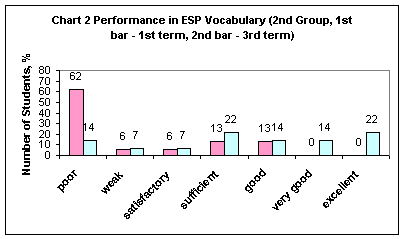Business English, Professional English, Legal English, Medical English,
Academic English etc.
Online Journal for Teachers
ESP World
ISSN 1682-3257
http://esp-world.info
English for Specific Purposes
|
They learn when they do; which isn’t often – on their own,
the hard way.
Robert Heinlein
HOMEWORK IN ENGLISH FOR SPECIFIC PURPOSES: IS IT EFFECTIVE?
Galina Kavaliauskienė
Law University of Lithuania
1Introduction
Controversy over advantages and disadvantages of homework assignments as an instructional
tool in language teaching has persisted for years. Recently there has been a renewed interest in homework issues. Some English language practitioners feel homework is inevitable and try to make the most of it, while others contemplate homework as having evil influence on learning motivation. Its proponents claim that homework fosters learning and enhances learners’ achievements. Its opponents maintain that homework deprives learners of leisure and lessens their motivation. However, what proponents and opponents of homework have in common is some uncertainty about the efficacy of homework assignments. Lack of relevant publications on learners’ attitudes to homework in English for Specific Purposes and ways of assessing the efficiency of homework in language learning aggravates situation.
This article addresses the issue of homework assignments in English for Specific Purposes. Two aspects of this issue have been considered. Firstly, the article describes the results of research into learners’ attitudes to homework assignments at University level carried out by the author. Secondly, it deals with the investigation of learners’ ongoing performance in ESP vocabulary and reading comprehension tests as a possible means of rating the efficacy of learning.
2Background to this study
Homework is defined as a set of activities done outside the class and without direct and real-time supervision of the teacher with direct or indirect linguistic and/or communicative objectives.
Homework is frequently seen as a necessary evil rather than as an important contribution to learner autonomy (Harmer, 2001:338): ‘college students have a number of different subjects to contend with, and English gets put to the bottom of the pile’. For adult learners, who are working in full-time jobs, the demands of self-study might interfere with work, family responsibilities, etc., and homework is more likely to be a burden than an effective way of learning.
Although American researchers have studied homework for over 60 years, they have not come to an agreement about the advantages and disadvantages of homework as an instructional tool (Cooper, 1994). Statistically, homework accounts for about 20% of the total time the typical American student spends on academic tasks.
The amount of time spent on homework at school varies. Less than an hour a day is the typical amount of time for American children. American high school students have one of the lightest homework loads in the world. Out of 20 countries, the USA ranks near the bottom in comparison with other countries, such as Japan where homework load is quite high. Nevertheless, in the USA, homework is considered a barometer of the success in raising academic standards. It is an integral part of the curriculum and is compulsory. Homework ‘enriches and consolidates, develops research skills and cultivates the mind to nurture the seeds of knowledge’ (online source: http://brookings.edu/comm/news/20031001brown.htm).
Three types of homework are described in (Eddy, 1984): Practice to reinforce newly acquired skills, Preparation students get ready for future activities in the classroom, and Extension long-term projects to be continued in class. The types of homework tasks may include: reading a text, doing exercises, writing an essay, translation, revision, summarizing, and project work.
H. Cooper (1994) reviewed research on homework and noted some positive and negative effects. According to Cooper, there are three types of positive effects, which are classified and described herein.
Firstly, immediate effects on achievement, including 1) better retention of factual knowledge, 2) increased understanding, 3) better processing of information, 4) better critical thinking, 5) curriculum enrichment.
Secondly, long-term academic effects, including 1) improved attitude toward school, 2) learning encouraged during leisure time, 3) better study habits and skills.
Thirdly, non-academic long-term effects, including 1) greater self-direction, 2) greater self-discipline, 3) better time organization, 4) more inquisitiveness, 5) more independent problem solving.
Among the negative effects Cooper pointed out: 1) satiation, which leads to loss of interest in academic material, 2) physical and emotional fatigue, 3) denial of access to leisure time and community activities, 4) cheating through copying from other students.
The qualities of effective homework that really supports learning are summarized in (http://www.hilton.k12ny.us/homework.htm) and are as follows: a) homework is meaningful and purposeful, b) its outcomes are clearly communicated, c) homework should be stimulating but not too complex, d) homework should be reviewed in class.
Extensive research into the literature on homework, which was published between 1988 and 2001, was carried out by C. Sharp (2001). According to this research, a) there is a positive relationship between time spent on homework and achievement at secondary school level; b) US research indicates that girls tend to spend more time on homework than boys; c) the correlation between time spent on homework and achievement should not be taken as an evidence that more time on homework necessarily leads to better achievement.
According to C. Sharps data, pupils attitudes to homework are positive. However, preferences indicate dislike of routine tasks (e.g. finishing off class work) which do not contribute to learning. Learners prefer interesting, challenging and varied tasks. There is lack of evidence on what works in terms of homework assignments. C. Sharp highlights some priorities for future research: assessment of the effectiveness of different homework tasks, approaches to marking and feedback, and impact of homework on learners attitudes.
Presently, homework is getting a renewed interest. The interest in the efficacy of homework (http://agpa.uakron.edu/k12/best_practices/homework.html) has resulted from three kinds of studies that pointed to: 1) increasing students’ achievements as a way of extending student engagement with academic learning, 2) cross-cultural achievements; for example, students in Japan and most European countries spend more time on homework, and 3) quantitative studies have found that the amount of homework is the most significant factor related to achievement.
Cherie Montgomery in her PowerPoint Presentation ‘Around the Block One More Time’ (online source: http://www.pen.k12.va.us/VDOE/Instruction/Language/block.ppt) expresses two divergent views. First, homework does not significantly contribute to scores in a student’s achievement test or competency test, second, increased time spent on homework has a positive effect on a student’s grades.
The angry opponents of homework claim that: ‘schools need to break their mold and make some drastic changes in their homework assumptions and assignments. Children do not belong to them 24 hours a day, 7 days a week. There is no data to support the assumption that homework is good for academic achievement or character development.
Homework is thought controversial, not only because of legitimate questions about its efficacy. Concern about homework is part of a growing apprehension in the US about the time pressures (Kralovec, Buell, 2001). Homework is labeled as the black hole in the education process. According to authors, three myths have persisted during the 20th century. The first myth is that homework increases academic achievement. Most researchers now concede that homework does not improve academic achievements. The second myth is students’ scores will never be competitive internationally if they do not do lots of homework. The third myth is that homework supporters want to dilute the curriculum and kowtow to the inherent laziness of students.
The issue of homework and whether it is effective has recently been raised at the IATEFL conference by M. A. Kaboodvand (2004). The researcher noted that very little research has been done to identify the efficiency of homework. A survey conducted by the presenter in Iran included 95 adult learners and 25 teachers. The findings of this research are: most students enjoy homework; their favorite assignments are grammar and workbook exercises, memorization of lyrics and translation; teachers and students think homework is a necessary and important component of language learning. In my opinion, it is questionable whether the findings would be similar in other countries. In particular, students’ interest in the memorizing of lyrics and translating seems rather unlikely.
Recently M. Thompson (2004:18) has reviewed positive and negative effects of developing homework policy identified by Cooper and Eddy’s views on three types of homework assignments. According to Thompson, a successful homework policy brings benefits both inside and outside the classroom.
Thus, this overview of available literature on research and policy on homework reveals contradictory views: supporters describe a number of advantages while opponents emphasize various disadvantages. What proponents and opponents have in common, however, is their insights into homework at secondary school. No references have been found to research into these issues at the tertiary level, although the amount of homework assignments that university students receive is often overwhelming. Undoubtedly, students bring to higher education their attitudes, habits, and stereotypes of doing homework at school. How effective is homework at tertiary level? Does homework enhance learning? Do learners enjoy doing various tasks outside classes?
This paper aims at answering these questions by presenting research findings on students’ attitudes to English for Specific Purposes homework at university level and by examining if homework influences efficiency of learning.
3Research methods
In this study, there were three streams of respondents studying Law and Social Work at Law University of Lithuania: full-time students of Police Faculty (first stream in the future reference), full-time students of Social Work Faculty (second stream in the future reference), and correspondence students of Social Work Faculty (third stream). The instruction time in English for Specific Purposes differed in all the streams. The first stream (45 students) had ESP for four semesters (four hours a week for two semesters, and three hours a week for two semesters), i.e. about 220 hours; the second stream (35 students) – for one semester four hours a week, i.e. about 60 hours; and the third stream (70 students) – for two semesters and ten hours per semester, i.e. 20 hours.
Throughout semesters, all the students received various homework assignments. The learners’ attitudes and preferences regarding homework assignments were researched either by administering questionnaires or interviewing the students, mostly during weekly counseling hours. The respondents’ ongoing progress was monitored through testing their performance in ESP vocabulary and reading comprehension. The collected data is presented and discussed in the following section.
4Research data and discussion
This section comprises two parts: the first part describes students’ attitudes to various homework assignments, and the second part analyses the results of the students’ ongoing performance tests in homework reading and acquisition of vocabulary.
4.1Learners attitudes to homework assignments
All the respondents were asked to answer 5 questions related to home assignments. The first question refers to learners’ likes and dislikes. Chart 1 summarizes the findings. The columns are grouped in threes – for each stream of learners. The first column presents data for the full-time students who study Law at Police Faculty; the second column – for the full-time students at Social Work Faculty, and the third – for the correspondence students at Social Work Faculty. In each group, there were learners who only sometimes liked homework, specifically, when the tasks aroused their interest.

Interestingly, the data for the first stream contradicts our previous findings (Kavaliauskienė, 2004:69). A year ago, only 7% of the same groups of respondents disliked homework, and 93% - liked it. It means there has been a negative change in attitudes to homework expressed by the same students.

In chart 2, the learners responses to various tasks are depicted. Reading ESP texts and doing such exercises as matching words and definitions, True or False, and multiple choice (1st, 2nd, 3rd and 4th sets of columns) have been ticked differently by respondents from the three streams. The highest percentage of readers (65%) is amongst correspondence students who in their learning mainly rely on reading professional materials, which may be explained by scarce instruction time. Learning vocabulary (6th set of columns) and practicing grammar (7th set of columns) seem acceptable to all the students but only to a certain degree: vocabulary - from 28% to 46%, and grammar - from 30% to 4%, respectively. The least favorite activities are writing summaries (5th set of columns) and preparing presentations (the last set of columns). In my previous research paper (Kavaliauskienė, 2004:69), the same students (47%) favored presentations as part of doing various study projects. Current dislike of making summaries and presentations seems totally transparent. Now that these activities have become exam-oriented, the students, who of necessity have to master writing summaries and making oral presentations, have developed a negative attitude to them.
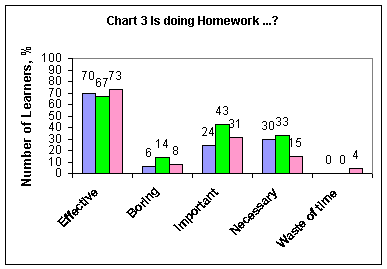
Chart 3 demonstrates the learners perception of homework efficacy, i.e. whether it is effective, boring, important, necessary or a waste of time. Quite unanimously, almost three quarters of the respondents in all streams agree that homework is an effective way of learning at one’s own pace and convenience (the first set of columns). Between approximately one fifth and one third of the respondents support the view of its importance and necessity (3rd and 4th sets of columns). The minority finds homework boring (2nd set of columns) and a few correspondence students believe homework is a waste of time.
The attitudes to the time spent on homework differ and are shown in chart 4. On average, students need between 1 to 3 hours to do their homework assignments. A few correspondence students admit never doing their homework (5% in the last column).

Chart 5 shows the students opinions on checking homework. Teachers feedback delivered through homework checking activity is thought to be necessary by about one third of the respondents (the 1st set of columns). The majority of learners, from 73% to 81%, find it useful (the 2nd set of columns). None of the respondents find checking homework useless, although a few think it is boring (the last set of columns of chart 5).
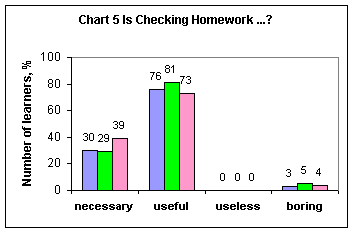
Summing up the research findings into the attitudes to homework assignments, it may be concluded that, all in all, only half of the respondents like homework, but three quarters agree it is an effective tool in learning ESP, and almost 80% in all streams believe that checking homework is useful.
4.2 Learners performance in ESP vocabulary and reading tests
The objective of this part of research was to investigate if homework assignments had any influence on the learners’ performance. Students were requested to read a professional text on a weekly basis and do a variety of exercises.
To study the effect homework assignments might have on students’ performance, three groups of learners were selected from the first stream, and two kinds of ongoing formal assessment of the learners’ performance were carried out: 1) an open-ended assessment of ESP vocabulary comprising 20 items was done twice per semester; 2) a written response based on homework reading – twice per semester. Some data on the learners’ ongoing performance are presented and discussed below.
relu ici
For the sake of visualization, following the pattern of previous section 4.1, the results are presented in bar charts. Each chart shows the data for a different heterogeneous class of students in the first and third semesters of an ESP course and allows us to estimate the learners’ achievement within the grade framework. The students’ performance is graded from 10 to 4, in accordance with the marking system used in Lithuania: 10 is ‘excellent’, 9 is ‘very good’, 8 is ‘good’, 7 is ‘sufficient’, 6 is ‘satisfactory’, 5 is ‘weak’, and 4 is ‘poor’.
It should be noted that the scoring was unbiased as the test items were scored as either correct or incorrect based upon the answer key.
The following three charts depict the students’ performance in learning ESP vocabulary. The first column in each chart shows the percentage of learners and their grades at the beginning of the course, and the second column – towards the end of the course.
The pink bars in Chart 1 present the distribution of the number of learners’ (in per cent) and their marks in the first semester, and blue columns – in the third semester (the first group). In this group, there is an observable shift towards more satisfactory performance. The number of poor marks decreased by 7%. The number of good performers has not changed significantly - merely from 27% to 33%.

The data for the 2nd group is shown in chart 2. At the beginning of the course, 62% of students demonstrated poor knowledge of ESP vocabulary, and only 13% were either sufficient or good at it. A year later, there was a visible shift to sufficient (22%), very good (14%) and excellent (22%) performance. Obviously, learners have improved their mastery of vocabulary.
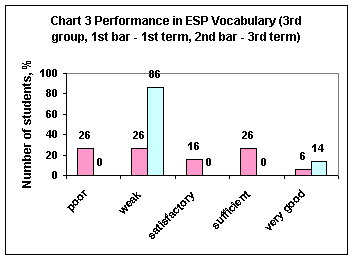
The data for the 3rd group is displayed in chart 3. At the beginning of the course, there was the same number of learners (26%) whose ESP vocabulary was poor, weak and sufficient. A year later, a great majority (86%) demonstrated weak knowledge, and just 14% - good. Assuming that some learners upgraded their knowledge of vocabulary from poor to weak, others must have degraded from satisfactory or sufficient level. Therefore, for the majority there have been neither achievements nor successful experience.
The performance in reading comprehension for the same three groups of students is demonstrated in the following three charts 4, 5 and 6.
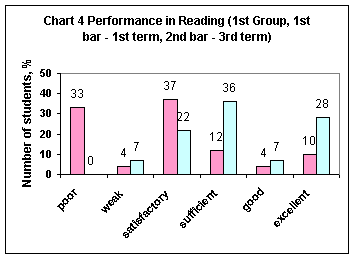
Chart 4 shows that there is an obvious improvement in the learners’ reading skills in the 3rd semester (blue columns) in comparison with the first semester (pink columns): there are no poor marks, and there is an increase in the number of grades between 7 and 10.
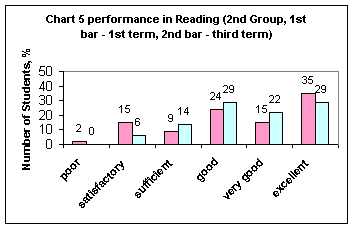
Chart 5 demonstrates a marked improvement in reading skills by approximately 5% at each mark. The only exception is the last column, where the number of excellent performers decreased by 6%.
Chart 6 shows the data for the third group. At the beginning of the course, their proficiency in reading skills was almost evenly distributed between poor and excellent marks (pink columns). In the third semester, a significant change was observed: 80% of learners demonstrated sufficient mastery in reading comprehension and 20% - good. The results for this group are rather unexpected because of the students’ unsatisfactory progress in terms of vocabulary.
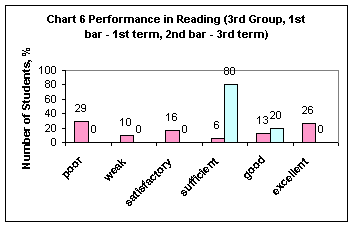
The numerous bar charts in this section aimed to demonstrate the diversity in performance among the students in different groups.
Now we have to answer the question formulated at the beginning of this article, i.e. whether homework assignments improve students’ acquisition of ESP vocabulary and reading comprehension, and therefore enhance the efficiency of learning. On the surface, it seems that the answer is ‘Yes’, because the learners’ marks became better – blue columns have shifted to the right in almost all the charts. Nevertheless, the data obtained raises some doubts. The students were also learning ESP vocabulary and practised productive and receptive language skills during classroom activities. This implies that an improvement in performance cannot be ascribed to homework only, and the interpretation of the findings is not unambiguous. In order to estimate the influence of homework assignments on learning efficiency, it is desirable to perform a ‘pure’ experiment without any classroom instruction. It is common knowledge, however, that self-study alone is rarely effective in learning a foreign language.
Data on the performance of learners who have a short instruction time in English might provide some valuable information. Unfortunately, such data on the performance of correspondence students is not available because they no longer take an English course and cannot be tested.
Conclusions
Our research into learners attitudes to homework assignments in English for Specific Purposes has shown that only half of the respondents like homework.
Three quarters of them agree that homework is an effective tool in learning ESP.
Almost 80% of the respondents in all streams believe that checking homework is useful.
The investigation of students’ performance in homework reading and ESP vocabulary has shown a general trend towards students’ getting better marks in tests, which implies that homework might enhance learning efficiency. However we cannot entirely ignore here the influence on the students’ performance of yet another variable – the development of language skills during contact hours in ESP classes.
References
1.Harmer, J. 2001. The Practice of English Language Teaching.3rd edition. Longman.
2.Eddy, Y.1984. Developing HomeworkPolicies.
http://www.kidsource.com/kidsource/content/HOW_IMPORTANT_HOMEWORK.html
3.Cooper, H. (1994). Homework Research and Policy: A Review of the Literature
Research/Practice, vol. 2, No 2. University of Minnesota.
Online: http://education.umn.edu/CAREI/Reports/Practice/Summer94/homework.htm
4.http://www.hilton.k12ny.us/homework.htm (authors name is not indicated)
5.http://agpa.uakron.edu/k12/best_practices/homework.html (authors name is not indicated)
6.http://brookings.edu/comm/news/20031001brown.htm (authors name is not indicated)
7.Sharp, C. Review of Studies on Homework.
http://www.nfer.ac.uk/htmldocs/Outcome_HWK.html
8.Montgomery, C.http://www.pen.k12.va.us/VDOE/Instruction/Language/block.ppt
9.Kaboodvand, M. A. Homework, is It Effective?
http://www.teachingenglish.org.uk/iatefl2004/christina 16 conf.shtml
10.Cease and Desist Order to Stop Homework. (authors name is not indicated).
http://www.webspawner.com/users/nohomework/ceasedesistorder.html
11.Kralovec, E. and J.Buell. 2001. End Homework Now. In Educational Leadership,
volume 58, No 7, pp. 39-42.
http://www.ascd.org/publications/ed_lead/200104/Kralovec.html
12. Thompson, M. Time Well Spent in English Teaching Professional. Issue 31, March 2004.
13. Kavaliauskiene, G. 2004. Preferences and Attitudes in Learning ESP. Tiltai. Nr 19.
Home ESP Encyclopaedia Requirements for Papers Guidelines for Authors Editors History
